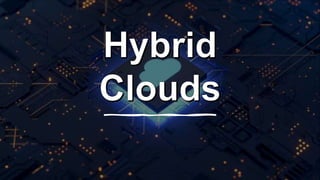The Cloud - CBSE Class 12 Computer Science
- 3. • Big networks like WAN (Wide Area Networks) consist of multiple large servers having unimaginable amount of data to store securely. • Google’s servers have a capacity of 15 exabytes (15,000,000,000GB)!!!
- 8. o Private clouds usually reside behind a firewall and are utilized by a single organization. A private cloud may be the preferred solution for businesses with very tight regulatory requirements, though private clouds implemented through a colocation provider are gaining in popularity. o Authorized users can access, utilize, and store data in the private cloud from anywhere, just like they could with a public cloud. o The difference is that no one else can access or utilize those computing resources. Private cloud solutions offer both security and control, but these benefits come at a cost. o The company that owns the cloud is responsible for both software and infrastructure, making this a less economical
- 9. o The additional control offered by a private cloud makes it easier to restrict access to valuable assets and ensures that a company will be able to move its data and applications where it wants, whenever it wants. o Since the private cloud isn’t controlled by an outside vendor, there’s no risk of sudden changes disrupting the company’s entire infrastructure. o A private cloud solution will also not be affected by a public cloud provider’s system downtime. o But private clouds also lack the versatility of public clouds. They can only be expanded by adding more physical compute and storage capacity, making it difficult to scale operations quickly should the business need arise.
- 11. Some public cloud examples include those offered by Amazon, Microsoft, or Google. These companies provide both services and infrastructure, which are shared by all customers. Public clouds typically have massive amounts of available space, which translates into easy scalability. A public cloud is often recommended for software development and collaborative projects. Companies can design their applications to be portable, so that a project that’s tested in the public cloud can be moved to the private cloud for production.
- 12. Most cloud providers package their computing resources as part of a service. Public cloud examples range from access to a completely virtualized infrastructure that provides little more than raw processing power and storage to specialized software programs that are easy to implement and use. The great advantage of a public cloud is its versatility and “pay as you go” structure that allows customers to provision more capacity on demand.
- 13. The essential infrastructure and operating system of the public cloud remain under full control of the cloud provider. Customers may continue to use the platform under the terms and conditions laid out by the provider, but they may have difficulty repatriating their assets if they want to change providers. Should the provider go out of business or make significant changes to the platform, customers could be forced to make significant infrastructure changes on short notice. There’s also the risk of an unpatched security vulnerability in the cloud architecture exposing customers to risk.
- 15. • Hybrid clouds combine public clouds with private clouds. They are designed to allow the two platforms to interact seamlessly, with data and applications moving smoothly from one to the other. • The primary advantage of a hybrid cloud model is its ability to provide the scalable computing power of a public cloud with the security and control of a private cloud. • Data can be stored safely behind the firewalls and encryption protocols of the private cloud, then moved securely into a public cloud environment when needed. • This is especially helpful in the age of big data analytics, when industries like healthcare must adhere to strict data privacy regulations while also using sophisticated algorithms powered by artificial intelligence (AI) to derive actionable insights from huge masses of unstructured data. • There are two commonly used types of hybrid cloud architecture.
- 16. Cloudbursting uses a private cloud as its primary cloud, storing data and housing proprietary applications in a secure environment. When service demands increases, like at the end of the financial quarter or during the holiday season, the private cloud’s infrastructure may not have the capacity to keep up. That’s where the public cloud comes in. A cloudbursting model uses the public cloud’s computing resources to supplement the private cloud, allowing the company to handle increased traffic without having to purchase new servers or other infrastructure. TYPE 1
- 17. The second type of hybrid cloud model also runs most applications and houses data in a private cloud environment but outsources non-critical applications to a public cloud provider. This arrangement is common for organizations that need to access specialized development tools (like Adobe Creative Cloud), basic productivity software (like Microsoft Office 365), or CRM platforms (like Salesforce). Multi-cloud architecture is often deployed here, incorporating multiple cloud service providers to meet a variety of unique TYPE 2
- 19. Although not as commonly used as the other three models, community clouds are a collaborative, multi-tenant platform used by several distinct organizations to share the same applications. The users are typically operating within the same industry or field and share common concerns in terms of security, compliance, and performance. In essence, a community cloud is a private cloud that functions much like a public cloud. The platform itself is managed privately, either in a data centre or on-premises. Authorized users are then segmented within that environment. These deployments are commonly used by government agencies, healthcare organizations, financial services firms, and



















